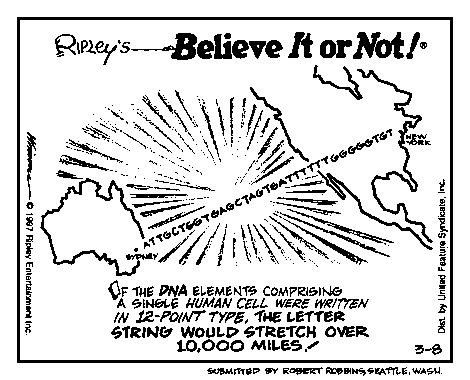|
Believe It, or Else!
|
|
The following cartoon appeared in March of 1997. |

|
|
BELIEVE IT OR NOT, getting this single sentence written and approved took more drafts, more revisions, more consultation, and more editorial effort than that spent on many scientific papers. The story of how this "major" publication came to be is detailed below...
|
|
A haploid copy of the human genome contains 3.3 billion base pairs of
DNA.
Typing that out as a list of A's, C's, T's, and G's in 10-pitch font (i.e., 10 characters per inch) would, by definition, generate a string of letters over 5000 miles long, since
Over many years of teaching, I used this simple fact to help people understand the scale of genomic numbers. Then, in October of 1996, I received the following unsolicited email message. |
|
Date: Thu, 24 Oct 1996 16:07:02 -0400 From: editor@ripleys To: rrobbins@gdb.org Subject: Believe It or Not! Robert: I spoke to Steven Salzberg regarding scientific facts to feature in the Ripley's Believe It or Not! cartoon. He cited a DNA illustration he uses in teaching. Though I may not express this properly. He suggests that if all the letter groups associated with one DNA helix were printed in 10 pt. type the string would be thousands of miles long! He noted that you are the author of this illustration and passed along your E-Mail address so that I may speak with you regarding this illustration and any other facts such as this which are typical of the kinds of things upon which Ripley's thrives. Please E-Mail a phone # and convenient time (your zone) when we may speak. Thanks! |
|
I responded to this inquiry, noting that 3.3 billion divided by
5280 divided by 12 divided by 10 was indeed equal to 5208, but
added that this result from simple division wasn't much of an insight.
The editor indicated that it was still of interest to Ripley's and asked if I would help draft a few words to summarize this factoid so that it could be used in a Believe It or Not! cartoon. I said, "sure," and only later discovered that this would require an exchange of many emails and voice mails, over several months, as we tried to converge on something that was simultaneously accurate, simple, and brief. Early discussions hinged on the difference between 10-pitch and 10-point font. Pitch is a measure of characters per inch, and point is a direct measure of size, where "point" is the unit of measure. It turns out that 10-pitch font is approximately 12 points in height, so we agreed to refer to "12-point font". A more significant problem occurred, when distinguishing between diploid and haploid cells was deemed too obscure, and the proposed description: |
|
Every human cell contains two sets of DNA, one received from each parent.
DNA is built as a string of four different components, so a DNA molecule
can be described as a long string of four different letters:
ATTCGGCTAC... If we tried to write out just one set of human DNA as a string of letters in 12-point type, then that string would stretch from .... to .... |
|
was deemed simultaneously too verbose and too complex.
An effort to eliminate the tricky concept of "one set of human DNA" by referring to "the DNA in a single human sperm cell" proved too racy for appearance in a family newspaper. Finally, after three months of kicking ideas around, the editor suggested we ignore the redundancy in a diploid cell and just double the length in miles: |
|
Date: Thu, 9 Jan 1997 12:39 (EST) From: editor@ripleys To: rjr8222@gmail.com Subject: Believe It or Not! Bob: Try this on for size........ Believe It or Not ! If the elements comprising the DNA in a single human cell were written in 12 point type, the letter string would be over 10,000 mi in length! I would use a cartoon of a globe with two cities appropriate in distance from one another connected by a ribbon of A.C.T. G.'s |
|
I agreed immediately and thought the publication was finally done. But, a few
weeks later, the editor contacted me, wanting to know what kinds of patterns of
A's, T's, C's, and G's should or should not be used if the illustration was to look like
"real DNA." I responded by sending him a copy of the full genomic sequence for human beta-hemoglobin,
taken from GenBank.
This pleased Ripley's, and finally the deed was done, and the cartoon appeared in March. Did they use part of the hemoglobin sequence? Maybe yes, maybe no. A BLAST search of GenBank using the sequence in the cartoon shows the following: |
HUMHBB U01317
(73308) Human beta globin region on chromosome 11.
Length = 73,308
Plus Strand HSPs:
Score = 97 (26.8 bits), Expect = 1.3, P = 0.92
Identities = 25/32 (78%), Positives = 25/32 (78%)
Query: 1 ATTGCTGGTGAGCTAGTGATTTTTTGGGGGTG 32
||||||||||||||||| |||| ||| |
Sbjct: 29756 ATTGCTGGTGAGCTAGTATGATTTTTTGGGGG 29787 |
|
The match is not perfect, but is too close to be due to chance. Apparently
"real" DNA needed editing, too.
|
|
Despite all the above, the project was fun and
I am looking forward to my next opportunity to publish a major
finding in Ripley's Believe It or Not! — perhaps the one about
synthesizing life from materials purchased in a drugstore, or maybe
elucidating fully the physical substrate of mind.
Robert J. Robbins |